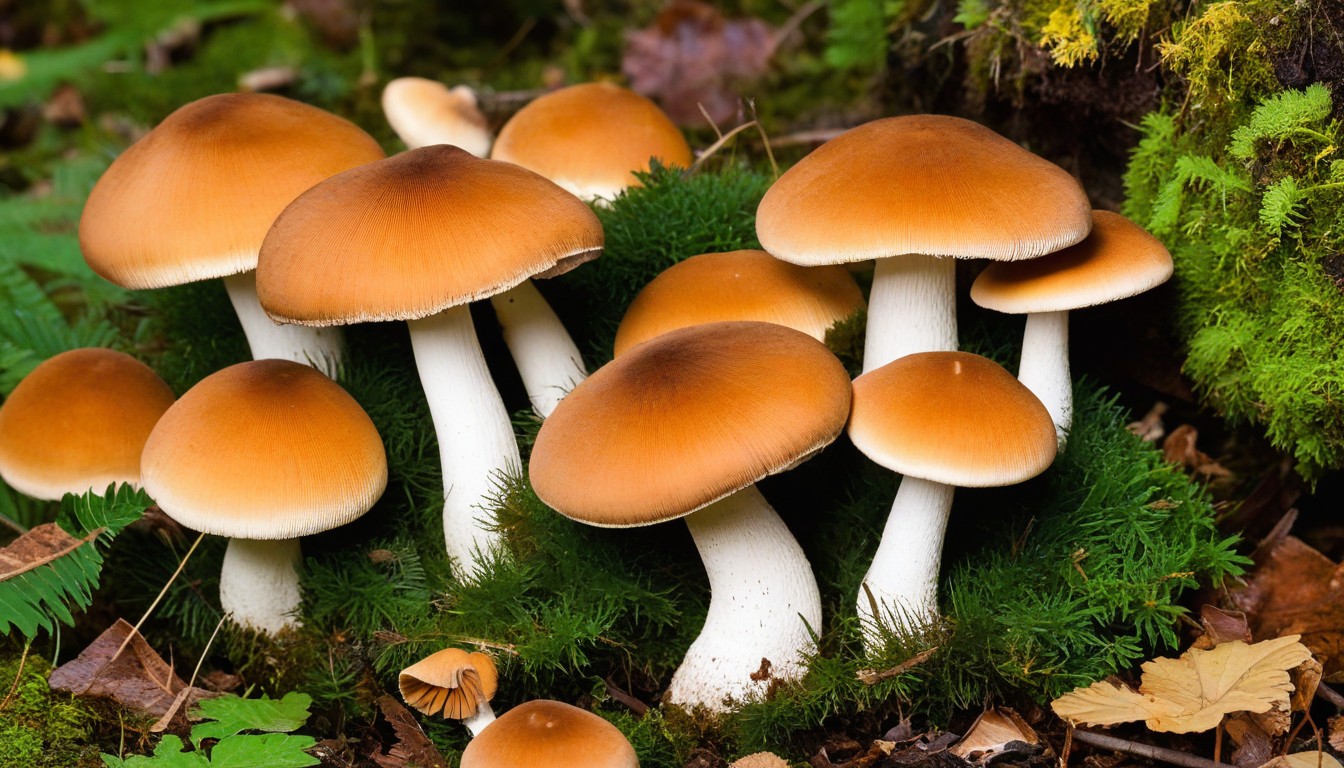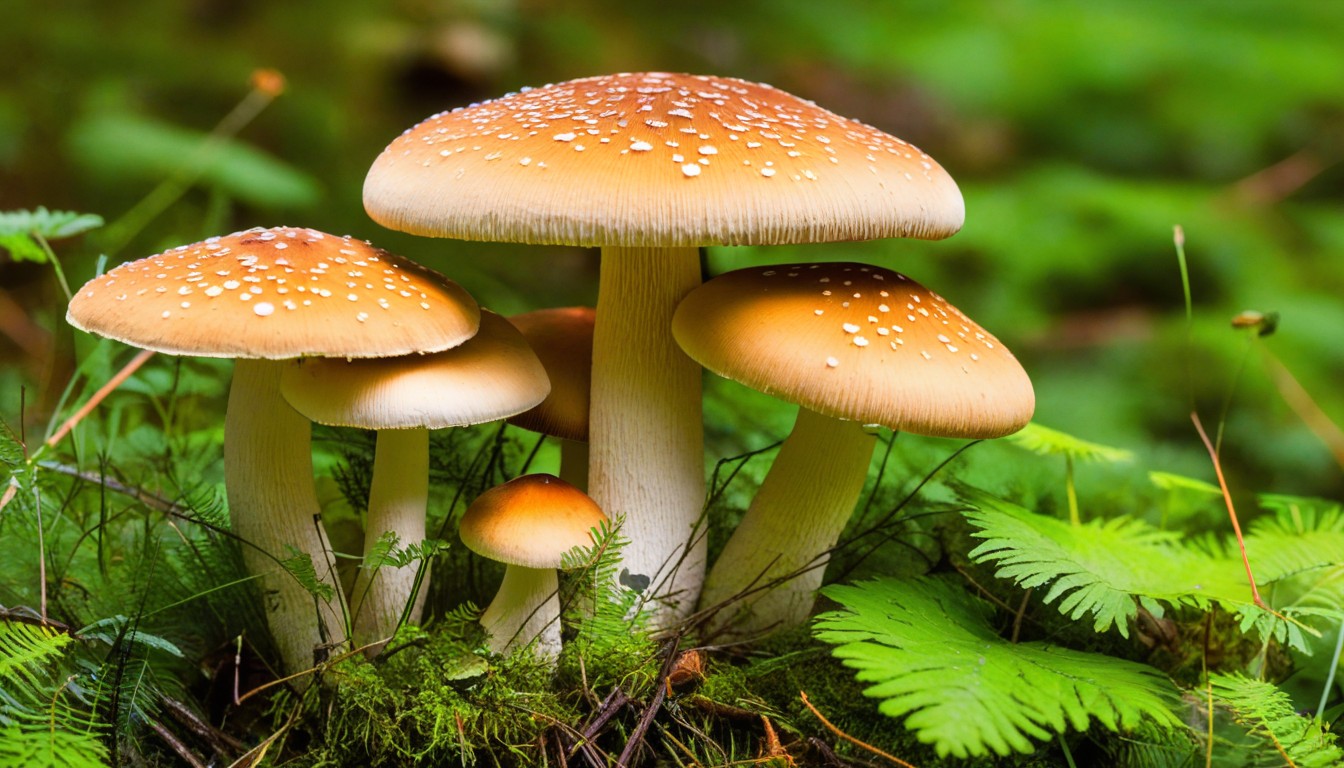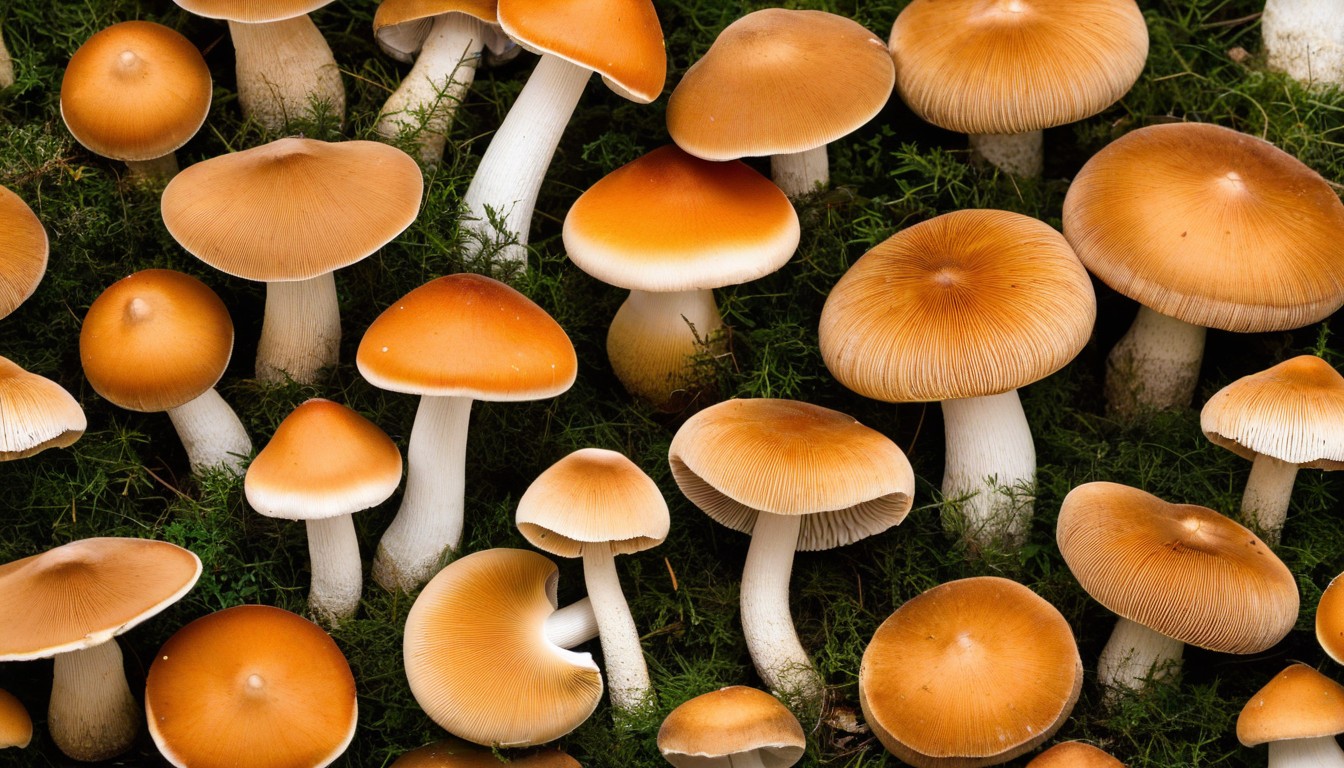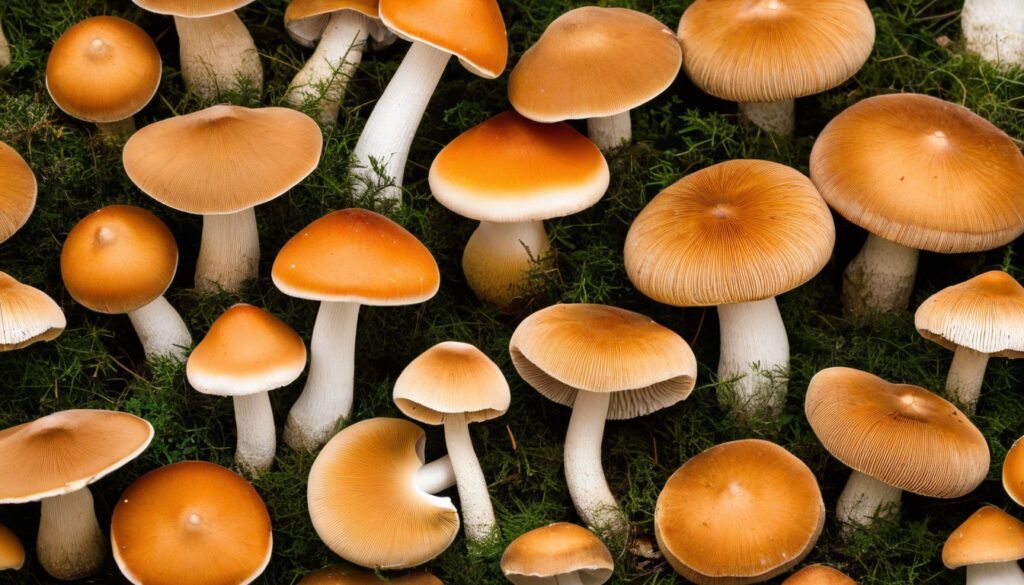Welcome to our comprehensive guide on edible wild mushrooms in Iowa, your ultimate resource for mushroom foraging. Foraging for wild mushrooms provides an opportunity to explore the rich diversity of Iowa’s natural ecosystems while discovering delicious and nutritious wild food sources. Whether you’re an experienced forager or just starting, this guide will equip you with the knowledge and skills needed to safely and confidently identify, harvest, and cook with edible wild mushrooms in Iowa.
In this guide, you will learn:
Key Takeaways:
- The basics of identifying edible wild mushrooms in Iowa’s forests and natural areas.
- Important safety precautions to take when foraging for wild mushrooms.
- The preferred habitat and seasonality of different types of edible mushrooms found in Iowa.
- Best practices for harvesting, storing, and preserving your wild mushroom bounty.
- How to cook a variety of dishes using Iowa’s edible mushrooms.
Understanding Edible Mushrooms
Before heading out on your mushroom foraging adventure, it’s crucial to learn how to identify and understand edible mushrooms. These fungi can be found in a variety of habitats, including forests, fields, and even your own backyard.
One of the most essential characteristics of edible mushrooms is their appearance. They come in various shapes, sizes, and colors, making it important to have a keen eye when identifying them. Some of the most common edible mushrooms found in Iowa include morels, chanterelles, and chicken mushrooms.
|
Mushroom Name |
Appearance |
Growth Pattern |
|---|---|---|
|
Morels |
Small, cone-shaped caps with distinctive pits and ridges. Vary in color from light tan to dark brown. |
Grows in wooded areas in the springtime |
|
Chanterelles |
Small, trumpet-shaped caps with wavy edges. Yellow or orange in color. |
Grows in hardwood forests during the summertime. |
|
Chicken Mushrooms |
Bright orange, with a smooth and slightly sticky cap and thick, fleshy stem. |
Grows on logs or tree stumps in the summertime and fall. |
Growth patterns are also important to take note of when identifying edible mushrooms, as different fungi thrive in different environments and at different times of the year. For example, morels often grow in wooded areas in the spring, while chanterelles prefer hardwood forests in the summer.
Once you’ve identified an edible mushroom, it’s important to learn about proper harvesting and preservation techniques to ensure the best taste and quality.
Now that we have a strong foundation in understanding edible mushrooms, let’s explore some safety precautions to consider while mushroom foraging in Section 3.
Safety Precautions for Mushroom Foraging
Foraging for wild mushrooms can be a fun and rewarding activity, but it’s important to prioritize safety. Toxic mushrooms can be found along with edible ones, and mistakenly consuming them can lead to serious illness or even fatalities. Here are some essential safety precautions to keep in mind:
- Always bring a field guide or expert forager with you – it’s essential to accurately identify the mushrooms you collect. Avoid consuming anything you’re unsure of.
- Wear appropriate clothing and footwear – Foraging can take you through rough terrain and harsh environments, so wear sturdy clothing and boots with good traction. Protect your hands with gloves.
- Use a sharp knife or scissors to harvest mushrooms – blunt instruments may bruise the mushroom, making them more susceptible to rot or molds.
- Avoid picking mushrooms growing alongside roads and highways – these areas tend to have pollutants in the soil which can be absorbed by mushrooms, making them toxic.
- Clean your mushrooms thoroughly – Rinse mushrooms off in water that you know is safe, brush off debris, and clean with a damp cloth, so no dirt remains.
- Store your mushrooms properly – Keep your mushrooms dry and in a refrigerated container wrapped with a damp towel. Consume or preserve them within a day or two.
By taking these safety precautions, you can have a safe and enjoyable foraging experience in Iowa’s mushroom-filled forests!
Top Edible Wild Mushrooms in Iowa
Iowa’s forests and natural areas are home to a variety of edible wild mushrooms that offer a unique taste and texture to any dish. Here are some of the top edible mushrooms for foragers to look out for:
|
Mushroom Species |
Key Characteristics |
Seasonality |
|---|---|---|
|
Morchella esculenta |
Distinct honeycomb-like cap and hollow stem. Varies in color from tan to brown. |
Spring (April-May) |
|
Cantharellus cibarius |
Yellow to orange cap with a funnel shape and a false gill pattern. |
Summer to fall (June-October) |
|
Laetiporus species |
Bright orange or yellow-orange, fan-shaped caps with a lemony or citrus-like aroma. |
Summer to fall (June-November) |
|
Pleurotus ostreatus |
Oyster-shaped, with a fan-like cap and short stem. Varies in color from white to grayish-brown. |
Year-round (especially in fall and winter) |
|
Lactarius deliciosus |
Orange to yellow cap with greenish tints, exudes a milky substance when cut. |
Summer to fall (June-November) |
Remember, while these mushrooms are edible and tasty, it’s important to properly identify them, practice safety precautions, and obtain permission before harvesting them from private land. Happy hunting!
Habitat and Seasonality of Edible Mushrooms in Iowa

If you want to find edible mushrooms in Iowa, it’s essential to understand where and when to look for them. Different mushroom species have their own preferred habitats and seasonalities, which means that some mushrooms are easier to find at certain times of the year in specific environments.
Preferred Habitats of Edible Mushrooms in Iowa
|
Preferred Habitat | |
|---|---|
|
Morels |
Deciduous forests, particularly near dead or dying trees |
|
Chanterelles |
Deciduous or mixed forests with moist soil and leaf litter |
|
Chicken mushrooms |
Hardwood trees, particularly oak and maple |
As you can see, different mushrooms prefer different environments. Knowing the preferred habitat of each mushroom species can help you narrow down the search area.
Seasonality of Edible Mushrooms in Iowa
Seasonal changes impact the growth and availability of edible mushrooms in Iowa. Here are some of the most common edible mushrooms in Iowa, along with their seasonalities:
- Morels: Late April to early May
- Chanterelles: July to October
- Chicken mushrooms: July to October
Keep in mind that these timeframes are not set in stone and can vary depending on the weather and other environmental factors. It’s always a good idea to keep an eye on the temperature and moisture levels in your area and adjust your hunting strategies accordingly.
By understanding the habitat and seasonality of edible mushrooms, you’ll be well on your way to finding and harvesting these delectable treasures in Iowa’s forests and natural areas.
Tips for Identifying Edible Mushrooms
Identifying edible mushrooms is essential for a successful mushroom foraging experience in Iowa. While it can be challenging to differentiate between edible and toxic mushrooms, employing some practical tips and visual cues can significantly reduce the risk of misidentification.
Tip #1: Study the Characteristics of Edible Mushrooms
Take some time to learn about the characteristics of edible mushrooms. Look for physical features such as cap shape, stem length, and color, as well as identifying marks such as gills, spores, and growth patterns.
“The first rule of mushroom foraging is never, ever eat a mushroom that you’re not 100% sure of.”
If you’re unsure about a specific type of mushroom, try to identify it using field guides, online resources, or consulting with experienced foragers.
Tip #2: Pay Attention to the Habitat and Season
Knowing the preferred habitat and seasonality of different mushroom species can also help in identifying edible mushrooms. For example, morel mushrooms tend to grow in wooded areas near rivers and streams during the springtime, while chanterelles can be found in the same environment but later in the summer.
Tip #3: Perform the Spore Print Test
Another way to confirm the identification of edible mushrooms is by performing the spore print test. This process involves collecting a cap from a mushroom, placing it on a white piece of paper, and allowing it to release its spores overnight. The resulting spore print can help differentiate between similar-looking species.
Tip #4: Join a Mushroom Foraging Group
Joining a local mushroom foraging group can be a great way to learn from experienced foragers and expand your knowledge of mushroom identification. Many groups offer guided foraging walks, workshops, and other educational opportunities.
|
Edible Mushroom |
Characteristics |
|---|---|
|
Morels |
Small, honeycombed cap; hollow stem; found in moist, wooded areas; springtime |
|
Chanterelles |
Bright orange-yellow, funnel-shaped cap; white to yellow stem; found in wooded areas and near rivers; late summer, early fall |
|
Hen of the Woods |
Large, grey-brown overlapping caps; white to yellowish-brown pores; grows at the base of trees; fall, winter |
|
Chicken of the Woods |
Bright orange-yellow shelf-like caps; no stem; grows in clusters on trees; late spring, early fall |
Identifying edible mushrooms takes time, practice, and patience. With these tips and visual cues, you can confidently identify and enjoy the delicious flavors of Iowa’s edible mushrooms.
Harvesting and Preserving Edible Mushrooms

Harvesting and preserving edible mushrooms is a crucial step in ensuring their quality and safety for consumption. It’s essential to understand the best practices for gathering mushrooms and storing them properly to retain their flavor and nutrients. Here are some tips on how to harvest and preserve your foraged treasures:
Harvesting Mushrooms
Before harvesting mushrooms, always ensure that you have correctly identified them as edible mushrooms. Avoid picking mushrooms that you are not sure of or those that are beyond their prime and have started to rot, as they are not safe for consumption. Also, avoid using plastic bags to store your mushrooms, as it can cause them to sweat and lose flavor.
When harvesting mushrooms, be gentle to avoid damaging the surrounding vegetation and other mushrooms. Cut the stem of the mushroom using a sharp knife or scissors, leaving the base and surrounding vegetation undisturbed.
Preserving Mushrooms
There are several ways to preserve your harvested mushrooms, including drying, freezing, and canning. Drying is an efficient way to store your mushrooms, and it preserves their flavor and texture. You can air-dry mushrooms or use a food dehydrator, ensuring that they are completely dry before storing them in an airtight container.
Freezing is another popular method of preserving mushrooms. Blanch the mushrooms first to remove any surface bacteria, then freeze them in an airtight container. You can also preserve mushrooms by canning them in oil, vinegar, or saltwater.
|
Preservation Method |
Description |
|---|---|
|
Drying |
Air-dry or use a food dehydrator to dry mushrooms completely before storage. |
|
Freezing |
Blanch mushrooms before storing them in an airtight container in the freezer. |
|
Canning |
Cook mushrooms in oil, vinegar, or saltwater and seal in canning jars. |
Whichever preservation method you choose, always store your mushrooms in a cool, dark place away from sunlight and moisture. Properly harvested and preserved mushrooms can last in storage for several months and can be used in a variety of dishes, adding flavor and texture to your meals.
Cooking with Edible Wild Mushrooms
After a successful foraging trip, it’s time to put your edible wild mushrooms to use in the kitchen. The unique flavors and textures of Iowa’s edible mushrooms can add a delicious and unexpected twist to a variety of dishes. Here are some cooking techniques and recipes to get you started:
Sautéing
Sautéing mushrooms is a quick and easy technique that brings out their rich umami flavor. Start by melting butter in a pan over medium heat. Add sliced mushrooms and sauté until they release their moisture. Continue cooking until the mushrooms are browned and crispy around the edges. Serve sautéed mushrooms as a side dish or add them to omelets, quesadillas, or sandwiches.
Grilling
Grilling mushrooms enhances their earthy flavor and imparts a smoky char. Brush whole or sliced mushrooms with olive oil and season with salt and pepper. Grill over medium-high heat until the mushrooms are tender and slightly charred. Serve grilled mushrooms as a side dish or use them to top burgers, salads, or pizzas.
Mushroom Risotto
Mushroom risotto is a classic dish that showcases the rich flavors and creamy texture of mushrooms. Start by cooking diced onions and garlic in butter until softened. Add Arborio rice and sauté until the rice is coated with the butter mixture. Gradually stir in chicken or vegetable broth, a ladleful at a time, until the rice is tender and creamy. Add sautéed mushrooms and Parmesan cheese and stir until heated through. Serve mushroom risotto as a main dish or side dish.
|
Recipe |
Ingredients |
Instructions |
|---|---|---|
|
Mushroom Soup |
1 lb. mixed mushrooms, sliced 1 onion, chopped 2 garlic cloves, minced 4 cups vegetable broth 1 cup heavy cream 1 tsp. thyme Salt and pepper, to taste |
1. In a pot, sauté onions and garlic in butter until softened. 2. Add mushrooms and sauté until they release their moisture. 3. Add vegetable broth and thyme and bring to a simmer. 4. Cook for 15-20 minutes, then blend the soup until smooth. 5. Stir in cream and season with salt and pepper. 6. Serve hot with crusty bread. |
|
Stuffed Mushrooms |
12 large mushrooms, stemmed 1/2 cup bread crumbs 1/4 cup grated Parmesan cheese 2 garlic cloves, minced 1/4 cup chopped parsley 2 tbsp. butter, melted 2 tbsp. olive oil Salt and pepper, to taste |
1. Preheat oven to 375°F. 2. In a bowl, mix bread crumbs, Parmesan, garlic, parsley, butter, and oil. 3. Stuff mushroom caps with the bread crumb mixture. 4. Bake for 15-20 minutes, or until golden brown. 5. Season with salt and pepper and serve hot. |
These are just a few examples of the many ways you can cook with edible wild mushrooms. To really let the flavors shine, keep it simple and let the mushrooms be the star of the show. Happy cooking!
Ethical Foraging and Conservation

As mushroom foragers, it is essential to practice ethical foraging and conservation to ensure the sustainability of our natural habitats and the species that inhabit them.
What is Ethical Foraging?
Ethical foraging means respecting and preserving the environment and natural resources while foraging for wild mushrooms. It involves following specific guidelines and principles to reduce the impact on ecosystems and prevent the depletion of mushroom populations.
- Only forage what you need and can consume.
- Stay on designated trails and do not venture into protected areas.
- Do not damage or disturb the surrounding vegetation and wildlife.
- Always obtain permission from the landowner before foraging on private property.
- Dispose of waste and litter properly.
Why Conservation is Vital?
Conserving wild mushroom populations entails preserving their habitats and natural environments, which have been gradually disappearing due to climate change, deforestation, and human activities.
By preserving our ecosystems, we provide a sustainable future for wild mushroom populations, which play a crucial role in maintaining ecological balance and enhancing biodiversity.
The Role of Mushroom Foragers in Conservation
Mushroom foragers can play a crucial role in conservation by becoming advocates of ethical foraging practices and promoting sustainable mushroom harvesting. By educating ourselves and others, we can reduce the impact of foraging on natural habitats and increase awareness of the importance of conservation efforts.
|
Conservation Tips for Mushroom Foragers |
|---|
|
Research the ecosystems, habitats, and species you forage, and stay updated on their conservation status. |
|
Join or support conservation groups that promote sustainability and environmental protection. |
|
Participate in mushroom surveys, citizen science programs, and other local environmental activities that promote conservation awareness. |
|
Share your knowledge and passion for ethical foraging practices with others. |
By incorporating ethical foraging and conservation practices into our foraging experiences, we can ensure sustainable mushroom harvesting for future generations to come.
Resources and Tools for Mushroom Foragers in Iowa

Exploring the delicious world of mushroom foraging in Iowa can be made easier and more enjoyable with the help of valuable resources and tools. To assist you in your journey, we’ve compiled a list of recommended resources and tools for mushroom foragers in Iowa.
Iowa Farmers’ Market Association
|
Website |
https://www.iafarmersmarkets.org/ |
|---|---|
|
Description |
The Iowa Farmers’ Market Association (IFMA) is a non-profit organization that supports local farmers’ markets throughout Iowa. The website provides information on farmers’ market locations, hours, and events where you can find fresh, locally grown produce, including wild edible mushrooms. |
Midwest Mushroom Identification Facebook Group
|
Website |
https://www.facebook.com/groups/MidwestMushroomID/ |
|---|---|
|
Description |
The Midwest Mushroom Identification Facebook Group is a community of mushroom enthusiasts who share knowledge and identify mushrooms found in the Midwest, including Iowa. Joining this group can be an excellent resource for learning, identification, and connecting with other foragers in the area. |
Field Guide to Edible Mushrooms of the Midwest
|
Image |
 |
|---|---|
|
Description |
Field Guide to Edible Mushrooms of the Midwest by Michael Kuo and Andrew S. Methven is an informative book that provides detailed descriptions, photographs, and distribution maps of edible mushrooms found in the Midwest region, including Iowa. This book is an essential guide for mushroom identification and foraging. |
Mushroom Knife
|
Image |
 |
|---|---|
|
Description |
A reliable mushroom knife is a crucial tool for any mushroom forager. This specialized knife typically features a curved blade with a brush, perfect for cleaning and harvesting mushrooms. Investing in a high-quality mushroom knife can make harvesting mushrooms in the field easier and safer. |
Mushroom Foraging Tours
|
Website |
https://www.wildfoodadventures.com/mushrooms-foraging-courses.html |
|---|---|
|
Description |
Joining a guided mushroom foraging tour can be an excellent way to learn about mushroom identification, safety, and ethical foraging practices. Local tour operators such as Wild Food Adventures offer guided tours in Iowa where experienced foragers lead you through the forests and share their knowledge of wild mushroom species. |
By utilizing these resources and tools, you can enhance your knowledge and passion for mushroom foraging in Iowa, while making your foraging experience safer, more efficient, and more enjoyable. Happy foraging!
Conclusion
Exploring the wonderful world of edible wild mushrooms in Iowa can be a fun and exciting adventure for foragers of all levels. Remember to always prioritize safety and ethical foraging practices to protect yourself and the natural habitat of these amazing fungi. Armed with the knowledge provided in this guide, you can confidently identify, harvest, and cook delicious meals using some of Iowa’s top edible mushroom species. Don’t forget to check out the recommended resources and tools to further expand your mushroom foraging skills and knowledge. Happy foraging!
FAQ
Can I eat any wild mushroom I find in Iowa?
No, not all wild mushrooms in Iowa are edible. It’s crucial to learn how to identify edible mushrooms and avoid poisonous ones to ensure your safety.
How can I learn to identify edible mushrooms?
There are many resources available, such as books, online guides, and mushroom identification classes, that can help you learn to identify edible mushrooms. It’s essential to study the characteristics and growth patterns of different species.
Are there any poisonous mushrooms in Iowa?
Yes, there are several poisonous mushrooms in Iowa, including the deadly amanita species. It’s crucial to be able to differentiate between edible and poisonous mushrooms to avoid any potential health risks.
What safety precautions should I take when foraging for mushrooms?
When foraging for mushrooms, always wear appropriate clothing and footwear, use a mushroom knife or brush to avoid damaging the fungi, and carry a field guide or app to help with identification. It’s also recommended to forage with an experienced forager and avoid consuming mushrooms you are unsure about.
Can I eat raw wild mushrooms?
It’s generally not recommended to eat raw wild mushrooms, as they can be difficult to digest and may contain harmful bacteria or toxins. It’s safer to cook them thoroughly before consuming.
Where can I find edible mushrooms in Iowa?
Edible mushrooms can be found in various natural areas, including forests, woodlands, and certain types of soil. It’s important to research the specific habitats and seasonality of different edible mushroom species in Iowa.
How should I harvest and preserve edible mushrooms?
When harvesting mushrooms, gently cut or twist the stem to remove them, leaving the mycelium intact. It’s important to only take what you will consume and leave some mushrooms behind for future growth. To preserve edible mushrooms, you can dehydrate them, freeze them, or store them in airtight containers.
Are there any regulations or permits required for mushroom foraging in Iowa?
Currently, there are no specific regulations or permits required for personal mushroom foraging in Iowa’s public natural areas. However, it’s always a good idea to check with local authorities or landowners for any specific guidelines or restrictions.
Can I sell the mushrooms I forage in Iowa?
Selling wild mushrooms in Iowa requires proper permits and adherence to state regulations. It’s advisable to consult with the Iowa Department of Natural Resources or local health authorities to understand the legal requirements for selling foraged mushrooms.
Are there any organizations or groups in Iowa for mushroom enthusiasts?
Yes, there are several organizations and groups in Iowa that cater to mushroom enthusiasts. These groups offer educational events, forays, and opportunities to connect with fellow foragers. Some notable organizations include the Iowa Mycological Society and local mushroom clubs.
Can I find morel mushrooms in Iowa?
Yes, Iowa is known for its morel mushroom season, typically occurring in the spring. Morel mushrooms are highly sought after by foragers due to their unique flavor and appearance.

